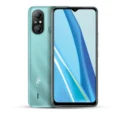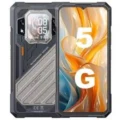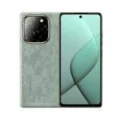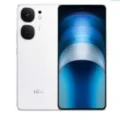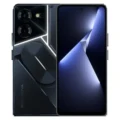itel Smart Watch 2





- :
- : 1.8" 240x286 pixels
- : 230mAh
- : NO
itel Smart Watch 2: Stay Connected and Active
Large Display: The itel Smart Watch 2 features a spacious 1.8-inch display, making it easy to view notifications, messages, and health data.
Bluetooth Calling: Stay connected without reaching for your phone. The watch allows you to make and receive calls directly through Bluetooth.
Music on the Go: Store music directly on the watch or connect your wireless earbuds for a convenient listening experience.
Multiple Sports Modes: Track your workouts with various sports modes, monitoring your progress and performance.
170+ Watch Faces: Personalize your watch with a wide selection of stylish and customizable watch faces.
Long Battery Life: Enjoy up to 12 days of battery life on a single charge, allowing you to stay active without worrying about constant recharging.
Water Resistant: The IP68 water resistance rating ensures your watch can withstand splashes, sweat, and even accidental submersion.
Overall, the itel_Smart Watch 2 offers a combination of style, functionality, and affordability, making it a great choice for those looking for a basic smartwatch with essential features.
Want to Learn More?
Visit the official website of itel for detailed information about the itel Smart Watch 2: itel Official sites
Still Unsure?
If you’re still unsure about your choice, explore other options from itel at your nearest store: itel Store
Specs
Network
| 2G Network GSM 850 / 900 / 1800 / 1900 - SIM 1 & SIM 2 (dual-SIM) CDMA 800 / 1900 | GSM 900, GSM 1800 |
| 3G Network | UMTS 850, UMTS 900, UMTS 2100 |
| 4G Network | LTE 850, LTE 1800 |
LAUNCH
| Announced | December, 2025 |
| Status | Available. Released 2023 |
BODY
| Dimensions | - |
| Weight | - |
| Build | Plastic back, plastic frame |
| SIMs SIM (Subscriber Identity Module) is a small card that contains mobile network subscriber's account information. This allows the phone using the card to attach to a mobile network. The SIM card is most commonly associated with GSM and UMTS mobile networks. Moving a SIM card from one phone to another allows a subscriber to switch mobile phones without having to contact their mobile network carrier. SIM cards can also be used by a phone to store limited amounts of data, such as phone numbers and text messages. |
No IP68 |
Display
| Display Type Display Technology => A number of display technologies and types used in mobile phones => TFT (Thin Film Transistor), IPS (In-Place Switching), OLED (Organic Light Emitting Diode), AMOLED (Active-Matrix Organic Light-Emitting Diode), Super AMOLED (an even advanced version of AMOLED), Resistive Touchscreen (Resistive touchscreens contain two layer of conductive material with a very small gap between them which acts as a resistance), Capacitive Touchsceen (Capacitive touchscreen technology consists of a layer of glass coated with a transparent conductor) | IPS LCD |
| Size | 1.8 inches |
| Resolution | 240 x 286 pixels (~207 ppi density) |
PLATFORM
| Operating System OS => Every computer system run on a base software called Operating System (OS). Operating System controls all basic operations of the computer (such as smartphone, PDAs, tablet computers and other handheld devices). The Operating System allows the user to install and run third party applications (apps), apps are used to add new functionality to the device. | Proprietary OS |
MEMORY
| Card Slot Memory Card Slot is a special slot for inserting a memory card. Memory cards allow you to expand the phone's built-in memory, A memory card (sometimes called a flash memory card or a storage card) is a small storage medium used to store data such as text, pictures, audio, and video, for use on small, portable or remote computing devices such as mobile phones, mp3 players, digital cameras. | No |
| Internal | Unspecified storage |
MAIN CAMERA
| Cameras Specs Today’s smartphones come equipped with a very comprehensive set of camera related specifications. Our smartphone, for many of us, has become our primary camera due to it being the one we always have with us. | No |
| Video | No |
| Camera Features | No |
SELFIE CAMERA
| Cameras Specs Today’s smartphones come equipped with a very comprehensive set of camera related specifications. Our smartphone, for many of us, has become our primary camera due to it being the one we always have with us. | No |
| Features | No |
| Video | No |
SOUND
| Loudspeaker | Yes |
| 3.5mm jack | No |
COMMS
| WLAN | No |
| Positioning | No |
| Bluetooth Bluetooth is a wireless communications technology for exchanging data between mobile phones, headsets, computers and other network devices over short distances without wires, Bluetooth technology was primarily designed to support simple wireless networking of personal consumer devices. | 5.1, A2DP, LE |
| Infrared Infrared connectivity is an old wireless technology used to connect two electronic devices. It uses a beam of infrared light to transmit information and so requires direct line of sight and operates only at close range. | |
| USB | No |
| NFC NFC (Near field communication) is a set of standards for smartphones and similar devices to establish peer-to-peer radio communications with each other by touching them together or bringing them into proximity, usually no more than a few inches. | |
| Radio |
Features
| Sensors Sensors are electronic components that detects and responds to some type of input from the physical environment. The specific input could be light, heat, motion, moisture, pressure and location, The output is generally a signal that is converted to use in computing systems, a location sensor, such as a GPS receiver is able to detect current location of your electronic device. | Accelerometer, heart rate, SpO2 |
BATTERY
| Battery Type Battery Type => Cell phones run on various kinds of batteries depending on the manufacturer, phone size or shape and features. There are basically four types of cell phone batteries => Lithium Polymer, Lithium Ion, Nickel Metal Hydride and Nickel Cadmium. | Li-Ion (Lithium Ion) |
MISC
| Colors | Black |
TESTS
Reviews
Disclaimer Note
We strive to maintain accurate and up-to-date content on our website for general information purposes only. Please refrain from using the material for business, legal, or any other decisions.




